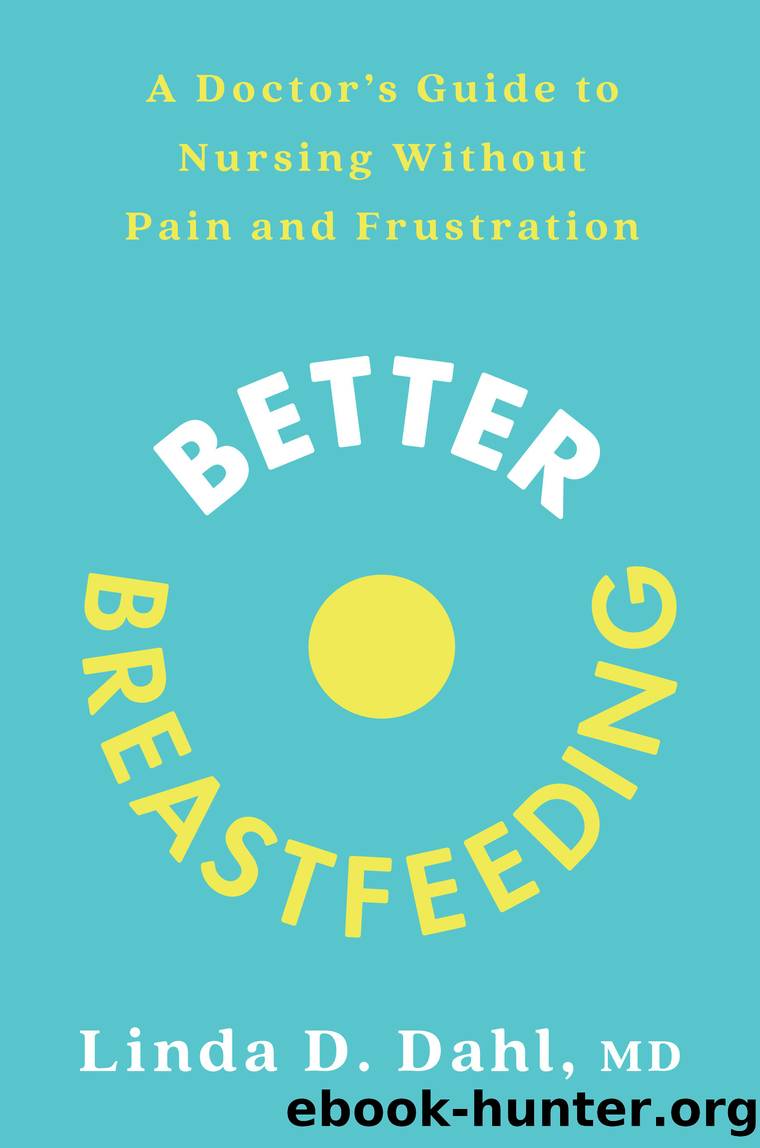Better Breastfeeding by Linda D. Dahl MD

Author:Linda D. Dahl, MD [Dahl, Linda D.]
Language: eng
Format: epub
Publisher: Harmony/Rodale
Published: 2022-02-08T00:00:00+00:00
9
Pain, No Gain: On Nipple and Breast Pain
The most common downside of breastfeeding is painâpain with latching, pain during nursing, pain after nursing. But, for some reason, it is rarely taken seriously. Instead, you get mixed messages and generalizations that cause more confusion than clarification. In the same breath you are promised that nursing is supposed to feel good, you are also assured that breastfeeding pain is completely normal. Besides the obvious paradox, no one even explains what kind of pain they are talking about. All pain is put into one category, lumped together and brushed aside, effectively brainwashing moms into expecting it.
Pain may be common, but itâs not normal. There are many varieties of breastfeeding pain, from mild and unavoidable to severe and potentially life-threatening. Pain can also be a powerful diagnostic tool, if you pay attention. It hurts because your body is trying to tell you something. Listen to it. If you break down the pain and examine it, the differences can help you figure out whatâs going wrong so you can look for ways to fix it.
Although pain can affect your mood, sleep, and energy level and make it nearly impossible to bond with your baby, it isnât just bad for you. It also means your baby is struggling in some very real way. Your pain can alert you that your baby isnât getting enough milk. It can also hint at why he has colic and cries all the time. If you ignore these clues, or just suffer like youâre told to, you may miss the chance to correct the problem. As we know, breastfeeding is all about timing. Donât wait until itâs too late.
For clarification, when someone tells you, âPain is normal,â what they really mean is a little pain for the first few days is expected. Breastfeeding is a learned skill, and although you and your baby are equipped with reflexes, you still have to sync up with each other to get it right. Engorgement as your breasts fill upâthat can hurt. Their firm, more solid shape can make it harder for your baby to latch onâthat hurts. Not latching your baby on deeply enough because you donât know how to hold all the parts togetherâthat hurts too. That is the extent of expected breastfeeding pain. Anything other than that is not okay. I repeat, anything other than a little pain for the first few days means something is wrong, no matter what anyone tells you. Pain can happen, but it is not a necessary part of breastfeeding.
In this chapter, we will discuss pain in detail, along with the very real ramifications of ignoring it. We will differentiate between nipple and breast pain, discussing the underlying causes of both. We will also talk about the quantifiable measures of pain, why it persists, and the repercussions of ignored pain, like infections, plugged ducts, decreased supply, and a higher risk of postpartum depression.
âNo pain, no gainâ may be true for many parts of life, but itâs not true for breastfeeding.
Download
This site does not store any files on its server. We only index and link to content provided by other sites. Please contact the content providers to delete copyright contents if any and email us, we'll remove relevant links or contents immediately.
| Breast Cancer | Candida |
| Chronic Fatigue Syndrome & Fibromyalgia | Endometriosis |
| General | Lupus |
| Menopause | Menstruation |
| Postpartum Depression | Pregnancy & Childbirth |
| Sexual Health |
Name Book, The: Over 10,000 Names--Their Meanings, Origins, and Spiritual Significance by Astoria Dorothy(2940)
Tone Your Tummy Type by Denise Austin(2787)
The Ultimate Guide to Anal Sex for Women by Tristan Taormino(2244)
The Coregasm Workout by Debby Herbenick(2221)
The Expectant Father by Armin A. Brott & Jennifer Ash(2219)
The Women's Health Fitness Fix by Jen Ator(2201)
Expecting Better by Emily Oster(2160)
She-ology by Sherry A. Ross MD(2133)
The Hite Report on Shere Hite by Shere Hite(2025)
Woman: An Intimate Geography by Natalie Angier(1883)
8 Steps to Reverse Your PCOS by Fiona McCulloch(1872)
Birth by Tina Cassidy(1864)
The Female Brain by M.D. Louann Brizendine(1857)
101 Get-Lean Workouts and Strategies by Muscle & Fitness(1808)
Women & the Weight Loss Tamasha by Diwekar Rujuta(1766)
50 Ways to Soothe Yourself Without Food by Susan Albers(1741)
The Big Booty Blueprint: Your Guide To A Bigger Butt In Less Than 12 Weeks by Bella Rahbek & Brandon Carter(1636)
Unleash the Power of the Female Brain: Supercharging Yours for Better Health, Energy, Mood, Focus, and Sex by Daniel G. Amen M.D(1531)
The overachievers by Robbins Alexandra(1528)
